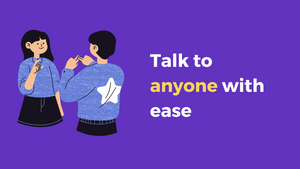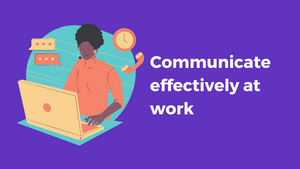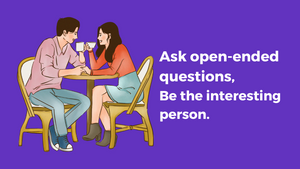
What are the best ways to improve communication skills
For every person on earth, Effective communication is a must-have skill. Effective communication can boost your confidence, open up new opportunities for you, and can help you to connect with people on a deeper level.
But there are many ways to improve your communication skills, how do you know which ones are best for you? In this article, we will discuss the best ways to improve your communication skills.
Table of Contents
- Why effective communication is important
- Identify Your Communication Style
- Develop Active Listening Skills
- Learn to communicate with confidence
- Use Non-Verbal Communication
- Practice empathy in communication
- Be Clear and Concise in Your Message
- Avoid Assumptions and Stereotypes
- Use Feedback to Improve Communication
- Conclution
Why effective communication is important
Effective communication is helpful in every aspect of life. It doesn't matter whether it's personal or professional.
We can use it to express our thoughts, ideas, and feelings, understand others, and build a strong relationships.
Effective communication is the foundation of success in every field, from education to business and beyond.
Good communication can improve productivity, teamwork, deeper understanding, empathy, and stronger connections.
Identify Your Communication Style
The first step is to identify your communication style, but what is a communication style?
What is a communication style?
Communication style is a way to communicate and exchange information with others in a specific tone or style. It is different for every person.
Types of communication styles
Before identifying your communication style you need to know how many types of communication styles are there.
Here are the most common ones
Assertive Communication Style
In this communication style people express their opinions and feelings respectfully and straightforwardly.
Aggressive Communication Style
In this communication style you express your opinions and feelings disrespectfully and forcefully.
Passive Communication Style
In this communication style people express their opinion and feelings while avoiding conflict and confrontation at the cost of their own needs and desire.
Passive-Aggressive Communication Style
In this communication style people express their anger in an indirect manner, such as through sarcasm or subtle dig.
Understanding Your Communication Style
The first step toward improving your communication skills is to identify your communication style. Here are some steps to understand your communication style
- Assess your communication style - Take a step back and ask yourself - Do I communicate assertively, passively, aggressively, or passive-aggressively?
- Evaluate the Results - Is your communication style you archive your goals and build a positive relationship with others?
- Be Mindful of Your Communication Style - While communicating are you being clear and respectful?
Develop Active Listening Skills
Communication is a two-way process. And active listing helps you build a good relationship, and improve overall communication.
What is active listening?
Active listening is a communication style that involves giving full attention to the person speaking and responding accordingly.
It means not only hearing what the person saying but also paying attention to their body language, tone, and emotions.
Benefits of active listening
- Better Understanding - It helps you to understand what the person's message is. which leads to fewer misunderstandings and productive communication.
- Building Trust - When you listen to someone with undivided attention, they feel heard and valued. Which build trust and strong relationship.
- Conflict Resolution - It helps you resolve conflicts by finding a mutually acceptable solution.
- Improved Decision-Making - It helps to collect all the necessary information before making a decision. Which results in better decision-making.
How to practice active listening?
- Pay attention - Give attention to the person speaking and maintain eye contact.
- Show Interest - Show that you are interested in the conversation by asking relevant questions and maintaining your body language.
- Ask to Clarify - If you don't understand something then ask the person to clarify it.
- Paraphrase - Repeat the person's message in your own words to ensure that you have understood it correctly.
- Reflect - You can show empathy and reflect on the person's emotions by acknowledging their feelings.
- Respond - Always respond appropriately and share your thoughts if needed.
Learn to communicate with confidence
Effective communication requires conveying information with confidence.
Importance of Confidence in Communication
Confidence helps you to express your opinion and feelings clearly and it can help you connect with your audience.
Because when you communicate with confidence you create trust in your audience. And they are more likely to take you seriously.
How to Develop Confidence in Communication
- Practice - Practice makes men perfect. Try to practice speaking in front of a mirror or with friends and ask for feedback.
- Prepare - Prepare and practice your speech. This will make you feel more comfortable and confident when it's time to deliver it.
- Be yourself - Don't try to be someone you are not. Authenticity will help you feel more confident and comfortable.
- Think positive - Think positively by reminding yourself of your past successes.
Tips for Communicating with Confidence
- Speak clearly - Speak clearly and at a comfortable pace. This will deliver your message more effectively.
- Make eye contact - Make eye contact with your audience to build a connection.
- Use body language - Do smile and nod while communicating. Use positive body language.
- Be concise - Be concise and to the point. This will help you to avoid rambling.
Use Non-Verbal Communication
It's not just about what you say; It's also about how you say it.
What is Non-Verbal Communication
Any communication that doesn't involve the use of words is non-verbal communication. It can include body language, tone of voice, and eye contact.
Non-verbal communication can convey a range of emotions, including happiness, sadness, anger, excitement, and more. It can also show your confidence and interest.
Types of Non-Verbal Communication
Posture
The way you stand and move communicates a lot of information. For example, standing tall and making eye contact can convey confidence, while slouching and avoiding eye contact can convey nervousness or lack of interest.
Facial Expressions
Human face can communicate emotions, such as happiness, sadness, anger, and surprise without saying a word. And it's the same across all the cultures around the globe.
The tone of voice
The way you say is as important as what you say. The tone of your voice conveys your emotions. Such as anger, and sadness.
Eye contact
Maintaining eye contact can convey trust, and interest. Eye contact is important to maintain the flow of communication.
How to Improve Non-Verbal Communication
- Practice - Try to pay attention to your posture, facial expressions, tone of voice, and eye contact while communicating. Practice using them to convey different emotions.
- Maintain eye contact - Always make sure to maintain eye contact when speaking with others.
- Smile - A smile is an expression of friendliness and can put others at ease.
Practice empathy in communication
Empathy helps you to develop a deeper understanding of others.
What is Empathy?
Empathy is the ability to understand and feel what another person is experiencing from their perspective.
Empathy is what makes us human.
It is not just about feeling sorry for them. It's about truly understanding how they feel and communicating with them in a way that shows you understand their emotions.
Importance of Empathy in Communication
It makes communication much easier when you can understand how someone else is feeling. This makes a strong relationship and trust.
How to Develop Empathy in Communication
Developing empathy takes time and practice.
- Listen actively - When communicating with someone, take time to listen, and pay attention to their tone, facial expression, and posture.
- Put yourself in their shoes - Imagine how the other person is feeling. By doing this you will be able to better understand how they are feeling.
- Avoid Judgement - Try to avoid judging people. Everyone has their perspective. Be respectful to others.
- Show support - Make the person feel that he/she is not alone. Let them know that you are there to support them. This builds trust and connection.
Be Clear and Concise in Your Message
In Effective communication one of the key components is the clarity of your message.
The Importance of Clarity in Communication
The clarity in your message eliminates misunderstandings, and confusion. Unclear communication can lead to potentially damaging relationships.
The clarity in your communication can create a sense of trust and understanding.
Tips for Communicating Clearly and Concisely
- Define your objective - Always clearly define your objective before you communicate. This will organize your thoughts.
- Use simple language - Always try to use non-technical terms and language that is simple for your audience. Try to avoid words that are not commonly used.
- Be concise - Always keep your message short if possible. Remove unnecessary details and make it to the point.
- Use examples - Provide examples if possible to help the audience understand your message clearly.
- Practice active listening - Listen to your audience and ask questions to ensure that they have understood your message.
Common Communication Mistakes to Avoid
- Assuming that the audience understands your message without confirming it.
- Being unclear in your communication.
- Interpreting the audience, and not allowing them to finish.
- Using negative language.
- Failing to consider the audience's point of view.
Avoid Assumptions and Stereotypes
Effective communication requires a willingness to understand, empathize, and communicate in a way that is respectful and accurate. One common barrier to it is assumptions and stereotypes.
What are Assumptions and Stereotypes?
Assumptions are ideas that we believe as true even if don't have the facts to support them.
Stereotypes are the assumption that we make about a group of people who share some characteristics in common. like gender, age, religion, etc.
Assumptions and stereotypes are negatively impactful and can make our communication biased.
How Assumptions and Stereotypes Affect Communication?
Assumptions and stereotypes affect communication negatively. For example, If we assume that we know what another person is thinking while communicating, we may jump to conclusions or make judgments that are not accurate and can lead to conflicts.
Stereotyping also impacts our communication in one way or another. It can lead to harmful generalizations, such as assuming that a certain group is dishonest or lazy. It creates an unwelcoming and negative environment in our communication.
Tips for Avoiding Assumptions and Stereotypes
The most important step in avoiding assumptions and stereotypes is to be aware of them. We should start by examining our own beliefs and assumptions, and challenge them if needed. We can also use active listening to avoid assumptions.
Another strategy is to stop making assumptions based on appearance, accent, background, and geo-location.
Remember, everyone is unique and has their perspectives.
Use Feedback to Improve Communication
Feedback is an important part of effective communication. It helps us to understand how our message is being received and how to improve it.
Importance of Feedback in Communication
Feedback is a critical part of effective communication. It tells us how our message is being received. It also tells us if our communications are achieving their intended purpose.
Feedback can also help us improve our communication skills. By actively asking for feedback, we can improve our skills.
How to Give and Receive Feedback
Communicating feedback is a challenging task. When giving feedback, try to focus on the behavior rather than the person.
For example, instead of saying "You are not communicating clearly", say "I am having trouble understanding what you are saying".
Always try to be open and non-defensive when receiving feedback. Even if we disagree with it. It is an essential part of communication to understand the other person's perspective. If we are unclear about the feedback then we should ask clarifying questions.
Tips for Using Feedback to Improve Communication
After receiving the feedback, it is essential to use it in our communication.
- Take action - After receiving feedback, we should take action and improve our communication skills.
- Practice - We can improve our communication skills by actively seeking feedback and practicing the skills.
- Monitor progress - Always monitor your progress to ensure that we are making improvements. You can ask your friends to help you with it.
Conclution
Effective communication is a fundamental skill that is essential in personal or professional communication. It can help you to build strong relationships, express your feelings, and understand others.
Rember that good communication is a two-way process. So give full attention to the person speaking and respond accordingly.




